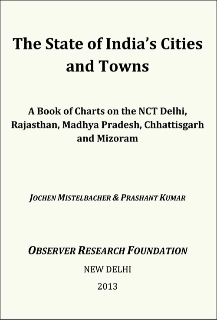India’s future is urban. According to the latest numbers provided by the Census of India (COI), more than 380 million Indians live in nearly 8,000 urban settlements of different size. Yet these urbanites still only make up one third of the total population. However, given the current speed of urbanisation driven by rural‐urban migration, natural growth of the urban population, reclassification of villages into towns and the incorporation of urban fringe villages into municipal boundaries, India’s urban population segment can be expected to cross the 500 million mark by 2021, and by 2050 more than half of India will be residing in an urban area. In the last 20 years this massive process of urbanisation has taken place within the well‐known context of liberalisation and high rates of economic growth, decentralisation and privatisation. Popular political mantras are repeated in numerous policy documents and speeches, ranging from “inclusive growth” at the national socio‐economic level, “integrated sustainable development” at the urban level, down to the “inclusive” and “world‐class city” at the individual city level. Yet, urban realities present a different picture: Lack, unequal access to and deficiencies in the provision of services and infrastructure, socio‐economic polarisation of the urban society, socio‐spatial marginalisation of the poor and minorities, fragmentation of urban space into areas included or excluded from overall development, the contestation of urban space by different actors, interests and stakeholders, and overall disparities between states, within states, and between and within cities and towns. Ultimately, these are all issues of governance.
It is election‐time. Shortly before the upcoming elections to the Lok Sabha in the beginning of 2014, voters in five States, namely the NCT Delhi, Rajasthan, Madhya Pradesh, Chhattisgarh and Mizoram, will have decided about the composition of their respective state assemblies for the next legislative period. With this Book of Charts, which is part of an ongoing project on the “State of India’s Urbanization”, we want to paint a numbers‐ and chart‐based picture of the current State of India’s Cities and Towns within these above mentioned states, and provide the public with a broad overview of selected urban topics, indicators and developments in the last decade. Thus, it is a story about the state and its people, the city and its citizens, and different sections of the population within the city as told by available data.
Naturally the framework of this Book of Charts is as well determined to a large extent by the availability of data specifically for urban areas. In this report we rely to a large extent on two data‐sources: The Census of India 2001 and 2011, and the 55th (1999‐2000), 61st (2004‐5) and 68th (2011‐12) round of the National Sample Survey (NSS) as provided by ORF India DataLabs. Within this framework we focus on selected indicators within specific core topics ranging from the economy and employment, consumption and assets, housing, infrastructure and services, education and health, of which most if not all can be attributed as important “election topics”.
As mentioned above, the urban scenario in India is to a large extent characterised by disparities and inequalities. The available data and indicators allow us to shed light on these issues and take a closer look at them at different levels of analysis which form as well the basic structure of this book. In Section I we take the state as the unit of analysis, asking how the selected states compare with each other and overall urban India (Interstate Disparities).
How and to what extent are disparities and inequalities manifested within the states, and how are they characterised in terms of different urban areas and sections of the society? How and to what extent have these changed during the last decade? These are the questions central to Section II (Intrastate Disparities), in which we look at the different topics as much as possible at different strata of the urban hierarchy (million+‐cities and Census Towns) as well as different sections of the urban society, i.e. Scheduled Castes (SC) and Tribes (ST), Other Backward Castes (OBC), Muslims and female‐headed households (FHH). Additionally, the traditional fault lines in Indian society along caste, religion, region or ethnicity are increasingly superimposed by economic or class divisions with the aam aadmi being put at the centre of political attention. Avoiding the traditional and extensive debates about poverty lines we chose to divide the state‐specific urban population into two sections according to the distribution of monthly household expenditure, thus taking a closer look at the top 70% and esp. the bottom 30% of urban society.
As mentioned above, the selected core topics are to a large extent issues and results of urban policies, urban governance, urban planning and development programmes, where public and academic focus has usually been more on developments in Megacities and Metropolises than in smaller Urban Local Bodies (ULB). By using a panel‐data set of selected indicators on infrastructure and services provision, we try in Section III (Intercity Disparities) to shed some light on the performance of and, by using available data for all statutory towns and cities in 2011, the prevailing infrastructural disparities between different size‐categories of Urban Local Bodies.
We are of course aware that apart from being constrained by the availability of urbanspecific data this picture is far from complete, leaving aside among others such important issues as the urban environment, energy and transportation or matters of urban finance. And to state the obvious, of course each of the core topics certainly does demand in‐depth study and research. However, we are confident that this Book of Charts can provide a useful background on current urban issues as well as a basis of analysis e.g. of urban election results in the respective states. And last but not least, the numbers behind and trends depicted in the following charts leave open large patches for debate and discussion.
The views expressed above belong to the author(s). ORF research and analyses now available on Telegram! Click here to access our curated content — blogs, longforms and interviews.

 PDF Download
PDF Download



 PREV
PREV



